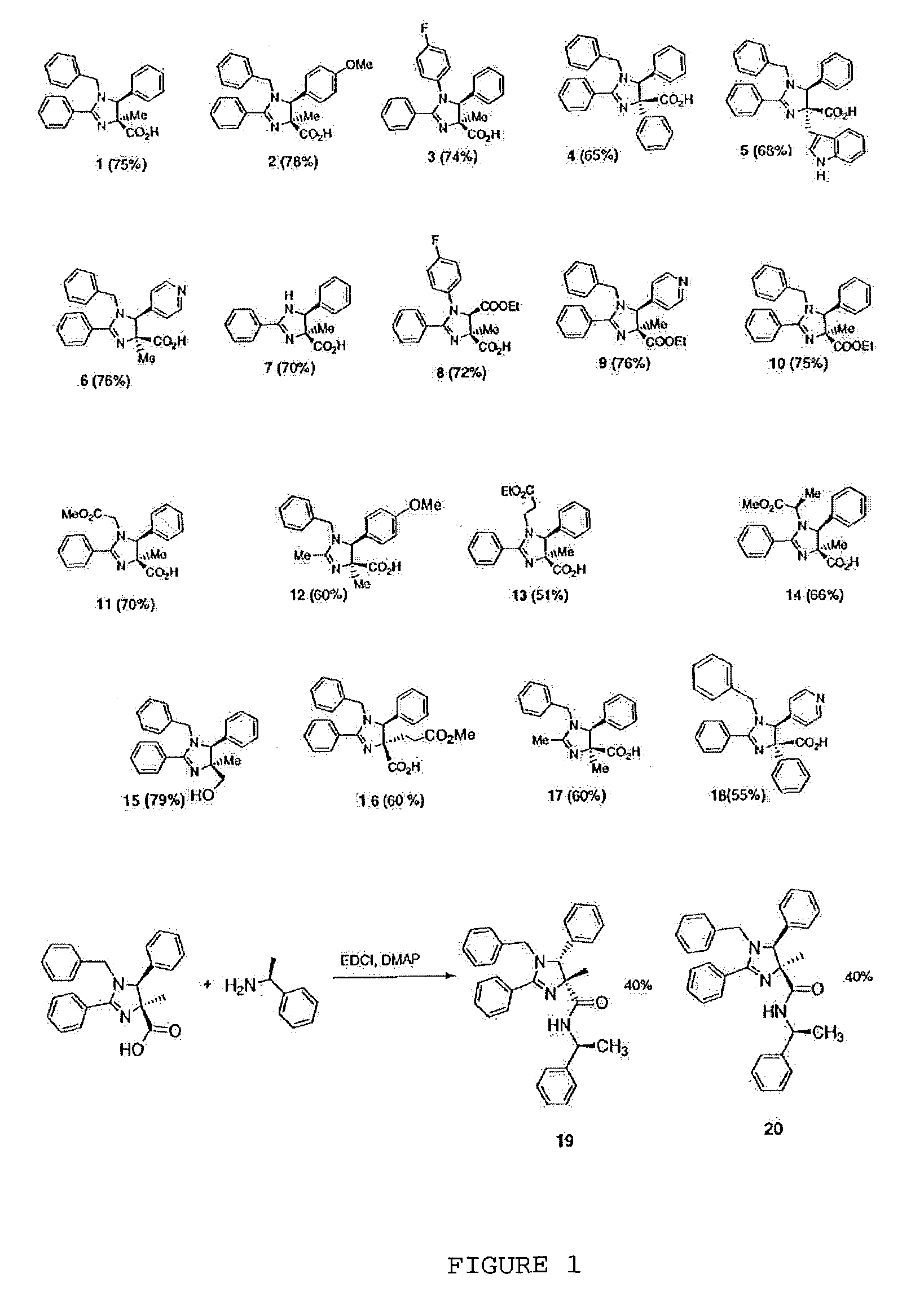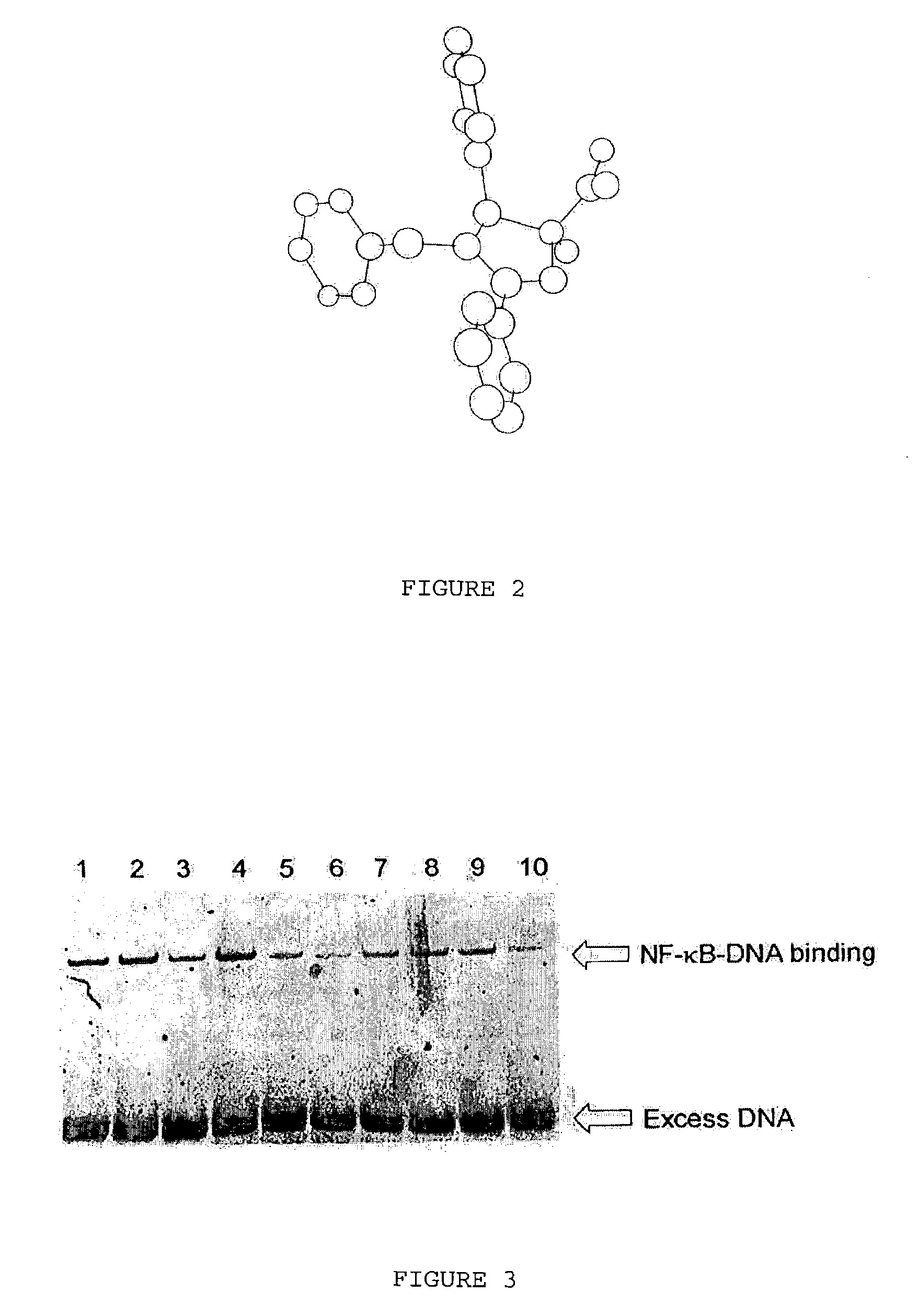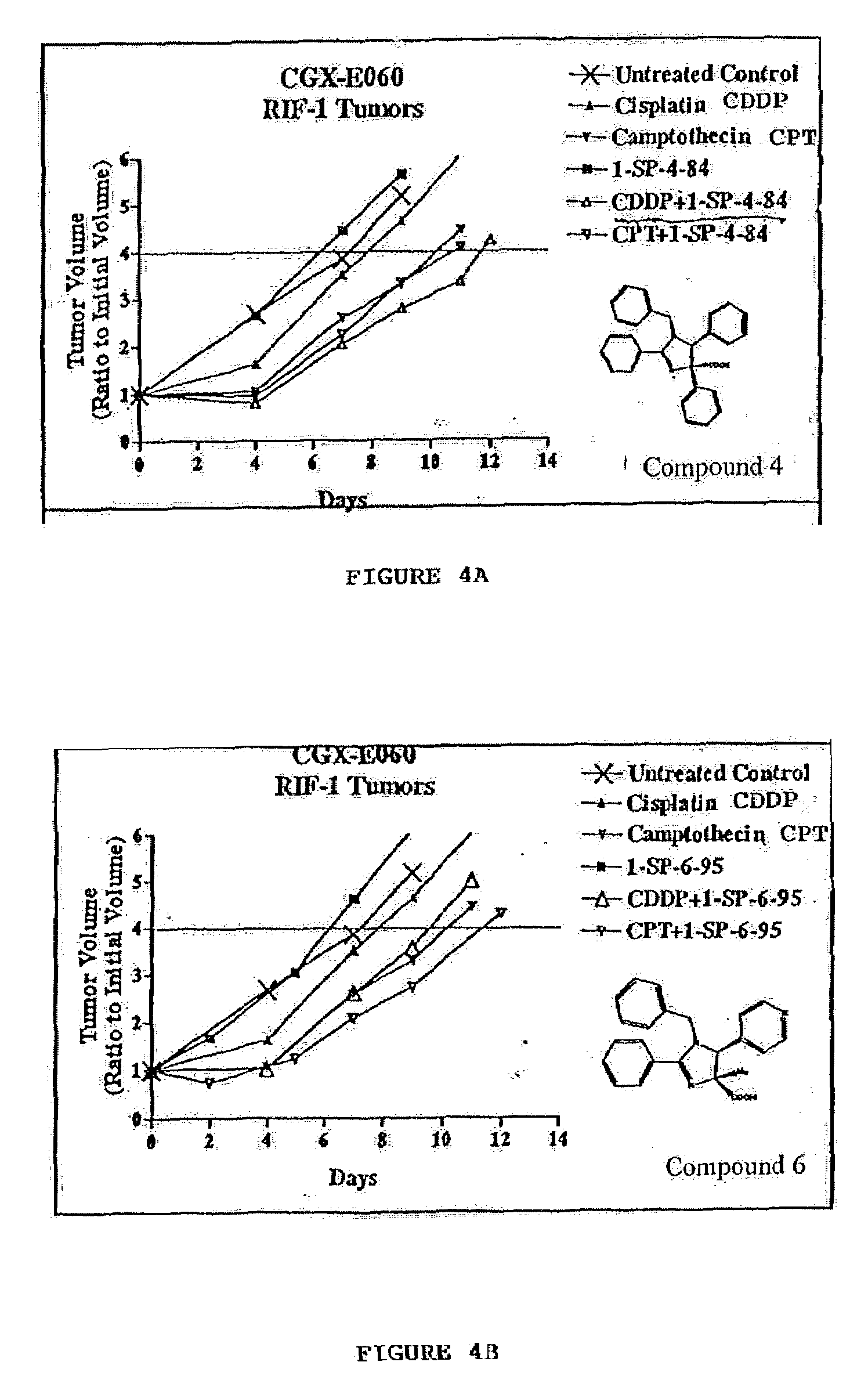NF-κB inhibitors and uses thereof
a technology of nf-kappab and inhibitors, which is applied in the field of new drugs, can solve the problems of multiple organ dysfunction, septic shock and death, and potentially fatal septic shock, and achieve the effect of inhibiting immune responses and immune responses
- Summary
- Abstract
- Description
- Claims
- Application Information
AI Technical Summary
Benefits of technology
Problems solved by technology
Method used
Image
Examples
examples 1-20
Experimental Section
[0151]Dl-(3S,4S)-1-Benzyl-4-methyl-2,5-diphenyl-4,5-dihydro-1H-imidazole-4-carboxylic acid SP-1-61 (1) was made as follows.
[0152]A solution of benzaldehyde (0.06 g, 0.57 mmol), benzylamine (0.061 g, 0.57 mmol) in dry dichloromethane (15 mL) was refluxed under nitrogen for 2 hours. 2-Phenyl-4-methyl-4H-oxazolin-5-one (0.1 g, 0.57 mmol) and chlorotrimethylsilane (0.08 g, 0.74 mmol) were added and the mixture was refluxed under nitrogen for 6 hours and then stirred overnight at room temperature. The reaction mixture was evaporated to dryness under vacuum. The product was precipitated out as a white solid using 1:1 dichloromethane / hexanes mixture (0.155 g, 74%). 1H NMR (300 MHz) (DMSO-d6): δ 1.8 (3H, s), 4.05 (1H, d, J=15 Hz), 4.95 (1H, d, J=14.8 Hz), 5.05 (1H, s), 7.05 (2H, s), 7.25-7.54 (8H, m), 7.74 (2H, t, J=7.2 Hz), 7.83 (1H, t, J=6.9 Hz), 8.0 (2H, d, J=8.4 Hz); 13C NMR (75 MHz) (DMSO-d6): δ 25.2, 48.8, 70.4, 73.3, 122.3, 127.8, 128.3, 128.5, 128.9, 129.1, 129.3...
example 21
[0190]All compounds were evaluated for their potential anti-inflammatory activity by examining the activity of NF-κB in vitro in nuclear extracts using the procedure from Breton and Charbot-Fletcher (Breton et al., J. Pharmacol. Exp. Ther. 282 459-466 (1997)). Briefly, Human Jurkat leukemia T-cells (clone E6-1; Amer. Type Culture Collection, Manassas, Va.) are grown in RPMI-1640 Media (Gibco-BRL, Bethesda, Md.) supplemented with 10% Fetal Bovine Serum, Penicillin (614 ηg / mL), Streptomycin (10 μg / mL) and Hepes Buffer, pH 7.2 at 37° C., 5% CO2. The Jurkat cells (1×107 cells / mL) are subsequently treated with various concentrations of imidazoline for 30 minutes at 37° C. followed by PMA stimulation (5.0 ng / mL) for an additional 5 hours. Nuclear extracts are incubated for 20 minutes with a double stranded Cy3 labeled NF-κB consensus oligonucleotide, 5′-AGTTGAGGGGACTTTCCCAGGC-3′ (SEQ ID NO:1) at room temperature. The crude mixture is loaded on a 5% non-denaturing polyacrylamide gel prepar...
example 22
[0194]All compounds were tested for their ability to inhibit NF-κB and the collected data is shown in Table 2. Currently, the most active compound in the series is the heterocyclic imidazoline 9 which exhibited 88% inhibition of NF-κB at 100 nM concentrations. Preliminary results indicate that the imidazolines do not exhibit significant cytotoxicity for up to 72 hours.
[0195]
TABLE 2Inhibition of NF-κB by imidazolines 1-10.compoundconcentration% inhibition11.0 μM19%21.0 μM68%31.0 μM35%41.0 μM65%51.0 μM 0%60.1 μM84%70.1 μM38%80.1 μM88%90.1 μM71%100.1 μM22%
The most active compound in this series was compound 8.
[0196]IC50 values in Mammalian Jurkat cells Leukemia T cells: IC50 value is defined as the concentration of compounds at which 50% of the protein / enzyme is inhibited in cells (Table 3).
[0197]
TABLE 3CompoundIC5011.95μM240ηM36.5ηM473ηM5nottested60.3μM720ηM
PUM
| Property | Measurement | Unit |
|---|---|---|
| temperature | aaaaa | aaaaa |
| temperature | aaaaa | aaaaa |
| particle size | aaaaa | aaaaa |
Abstract
Description
Claims
Application Information
 Login to View More
Login to View More - R&D
- Intellectual Property
- Life Sciences
- Materials
- Tech Scout
- Unparalleled Data Quality
- Higher Quality Content
- 60% Fewer Hallucinations
Browse by: Latest US Patents, China's latest patents, Technical Efficacy Thesaurus, Application Domain, Technology Topic, Popular Technical Reports.
© 2025 PatSnap. All rights reserved.Legal|Privacy policy|Modern Slavery Act Transparency Statement|Sitemap|About US| Contact US: help@patsnap.com



